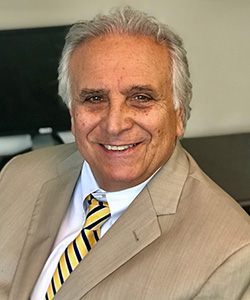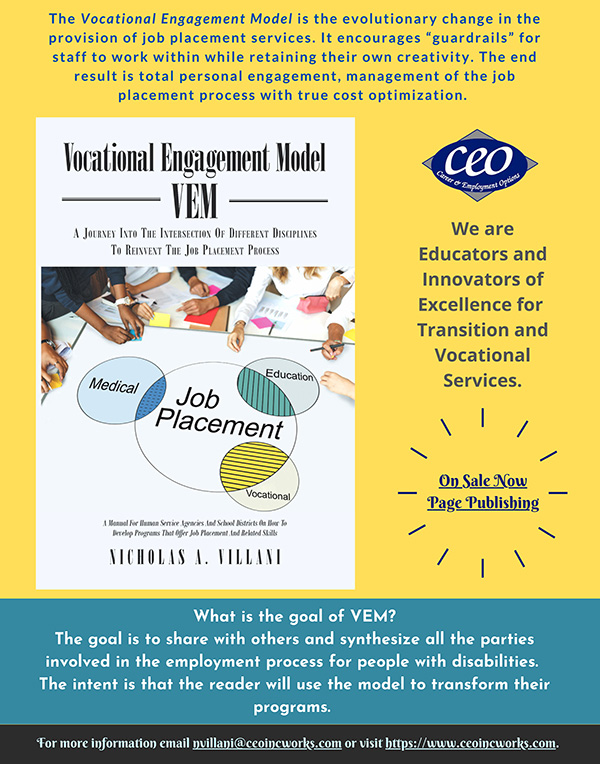Understanding the differential in the employment rates for people with disabilities and those without, including the length of time it has remained unchanged, requires an introspection into all the current practices and models. It also begs the question of “why” this has remained for so long and “why” this discrepancy still eludes the people involved, their families, educators and vocational rehabilitation professionals.

Nicholas A. Villani
The average employment rate for people with disabilities in New York State has remained in the mid-thirty percentile since 2008 until 2018 (Disabilitystatistics.org). Individuals without disabilities are in the high seventy or low eighty percentile. We may have yet to fully comprehend “why” our society has unintentionally created a caste system that inhibits the integration of individuals with disabilities into the workforce.
Our field’s response to address this social ill is often defining the benefits to businesses and outreach to them for education toward employing people with disabilities. The answer may be more complicated than just businesses needing to be educated in pursuing and hiring all individuals equally. If that were the case, there wouldn’t be discrepancies in any ethnic or racial group in the American workforce or the continued lack of improvement for people with disabilities in the workforce. The inequity to participate in the workforce mimics the conditions of other caste systems that implemented and sustained for very different reasons but leaves us with the same result.
Individuals with disabilities have been relegated to a lesser role or excluded from the workforce not due to their ability or lack thereof but as the result of this caste system that starts with these unequal systems. The real answer may start in the recognition that we have a caste system that starts while in elementary, middle and high school leading into college and eventually into the workforce. The systems (special education and vocational rehabilitation) that are intended to address this condition have had minimal impact upon the employment rates with little to no change for at least the last twenty years. What may be missing is a truly integrated system for acknowledging and combining resources and flipping the paradigm regarding who is educating who.
In Isabel Wilkerson’s book “Caste,”1 she explains that the historical context of the suppression of these groups was the result of racial, religious and ethnic prejudices. Those in the lower caste are suppressed and unable to fully engage in their society. After describing the effects, she also states the negative economic impact that this suppression creates. Clearly the situation in America with people with disabilities is not the same as those examples and without the animus those cultures adopted. Truth be told, our caste system for people with disabilities is silent and may be the result of a long-standing sense of powerlessness baked into the students during their experience in schools by the lack of preparation for their career world. In essence, the children and adults in that caste are the children of those people not in a caste. In turn, the silo effect of businesses, special education and rehab providers only intersecting when a person graduates may be over, as the awareness of unemployment becomes more prevalent. The lack of integrated thought contributes to the problem and maintains the caste system.
Each party in the paradigm failing to integrate innovation and communication is part of the issue. The vocational rehabilitation field’s failure is integrating new innovations regularly and only through incremental regulation changes. The business world’s shortcomings fall on the overreliance on over-competitive models for recruitment and hiring with no long-term positive effectiveness demonstrated. Included should be training and support for all employees not just those with “visible” disabilities. Lastly, special education’s sense of disconnect to the employment situation of their former students cannot be ignored. Graduating is not the only goal; preparation for a career life through transition supports should be emphasized. Each party of the paradigm is creating a silo effect of operating independently while not acknowledging or pursuing how to address this issue through an inverted model. The sense of normalcy left by each party leaving each other to solve the problem while unintentionally reinforcing the status quo creating a de facto caste system is almost impossible to eliminate.
Educating the Educators
What would be a major step forward is an inverted model of developing training of educators and vocational rehabilitation staff by business professionals in how they train their employees. “Educate the Educators” in how businesses operate and train would break the barriers using communication. The business of employers is to enable their business to grow and thrive. The business of special educators and vocational rehabilitation is to enable their students and clients to grow and thrive. Let’s connect the two missions.
Providers of services must be exposed to training and hiring practices that businesses use to improve their instruction. Although Universal Design Learning models are gaining traction, currently educators and rehab professionals are only exposed to the needs of business at the time the person is crossing the threshold to graduation or employment. What is needed are Superintendent Days that are filled with teachers learning from the business sector on how they train their employees. The academic requirements, the social requirements, the skills for comprehension and problem solving for successful training of employees should all be taught to teachers. Teachers can integrate those initiatives when providing instruction. The specifics of how those skills are measured and tracked by the business for their employee’s benefit should be integrated into curriculum. Starting to recognize and be cognizant of this at the earliest ages would enable teachers and providers the capacity to integrate those training practices into the curriculum or pedagogical practice.
Rehab professionals during their intake and preparation for the employment can inject business practices into their preparation and instruction. Also, if rehab professionals were regular participants in business trainings, we can offer those businesses insight into the needs of people with disabilities in their learning and social requirements.
In our agency I have implemented a program called Career Lab for schools that includes not only instruction in career skills but integrates business leaders into the instruction and measurement. They rate students on their elevator pitches and interview skills. This year we will be working with our Business Advisory Council to develop an instruction module for them to provide to teachers and rehab professionals. We also use this model for Vocational Engagement Model, which is clarified in my book,2 “VEM, A Journey Into the Intersection of Different Disciplines to Reinvent the Job Placement Process.”
Eliminating a caste system is a daunting challenge taking time, communication and commitment. If you or your child is a person with a disability, the time is now! How to impact the employment of people requires an acknowledgement of the condition and an intersection of each discipline and stakeholder to communicate and learn from each other to affect meaningful change. Let’s invite businesses to the process and let’s ensure that students and adults with disabilities, their families, schools and rehab providers integrate different disciplines into the process to eliminate the caste system that has so unfairly impacted the students and adults.
Nicholas A. Villani, President and CEO of Career and Employment Options, Inc., has worked in the field of vocational training and employment for people with special needs since 1982. He has administered programs, written grants, designed programs and was influential in much of the progress in the field of supported employment and transition for individuals with disabilities. As a presenter, he has trained hundreds of professionals in the field of vocational services across the United States. Mr. Villani was the administrator and oversaw the operations of services in the field of transition, vocational rehabilitation and day programs for major not-for-profit agencies on Long Island. Nick has been a leader in the field serving on the associations for the employment of individuals with special needs and has worked for not-for-profit and for-profit organizations performing transition services since 1990.
For more information email nvillani@ceoincworks.com or visit www.ceoincworks.com.
Footnotes
- Isabel Wilkerson, Aug 2020 “Caste: The Origins of Our Discontents” Penguin Random House
- Nicholas A. Villani, Feb 2021 “The Vocational Engagement Model: A Journey Into the Intersection of Different Disciplines to Reinvent the Job Placement Process” Page Publishing. The intersection of different disciplines Page Publishing






